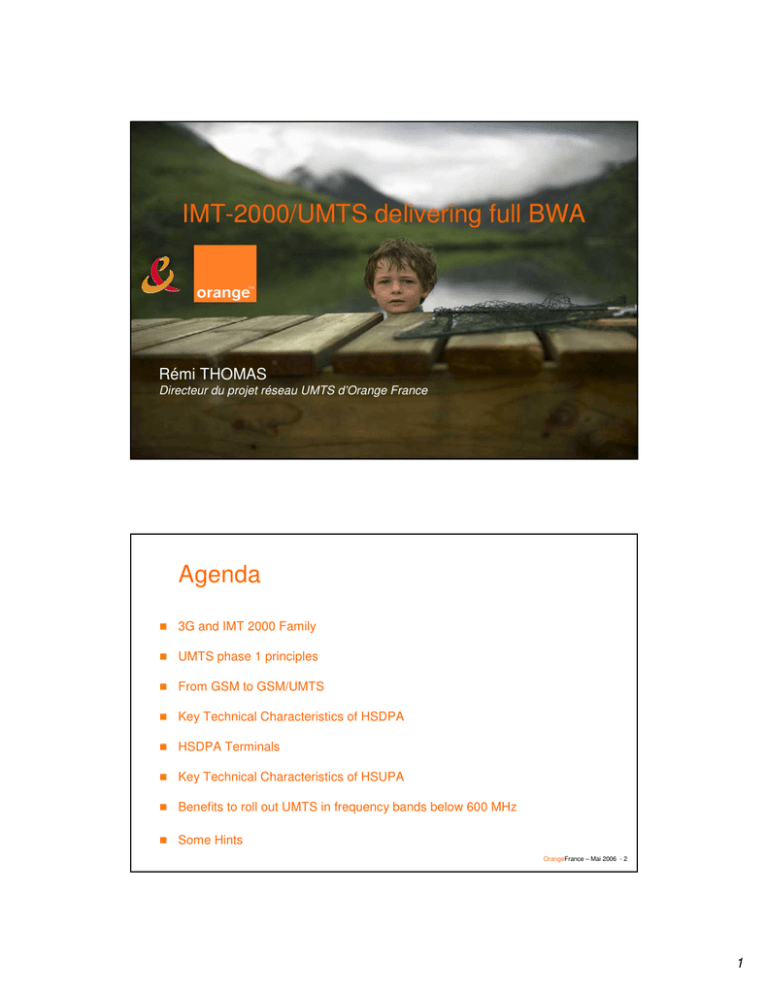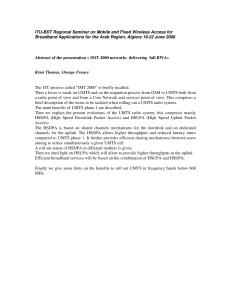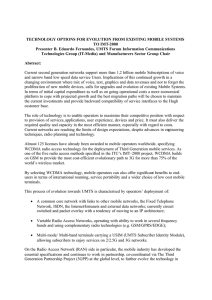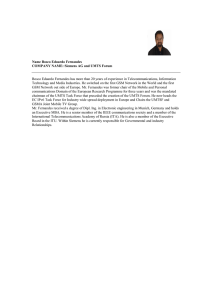IMT-2000/UMTS delivering full BWA Agenda Rémi THOMAS
advertisement

IMT-2000/UMTS delivering full BWA Rémi THOMAS Directeur du projet réseau UMTS d’Orange France Agenda 3G and IMT 2000 Family UMTS phase 1 principles From GSM to GSM/UMTS Key Technical Characteristics of HSDPA HSDPA Terminals Key Technical Characteristics of HSUPA Benefits to roll out UMTS in frequency bands below 600 MHz Some Hints OrangeFrance – Mai 2006 - 2 1 3G and IMT 2000 family OrangeFrance -Mai 2006, - 3 « IMT 2000 Family » concept ITU defined the criteria which shall be met by a standard in order it is seen as a 3G standard. The following frequency bands have been recommended for the IMT 2000 systems 1885 - 2025 MHz 2110- 2200 MHz OrangeFrance – Mai 2006 - 4 2 IMT 2000 standards UIT has defined five IMT-2000 Terrestrial Radio Interfaces : FDD mode of UMTS TDD mode of UMTS cdma2000 (IS95 evolution) UWC136 : this is an evolution of IS136, it relies on EDGE and GPRS DECT These Radio Interfaces are evolutions of 2G standards UMTS is a migration from GSM. It is the result of an agreement between the GSM world (network principles, services) and Japan (radio access technology) > This alliance between Europe and Japan is a very important fact. As a matter of fact it yielded that the footprint of UMTS will contain the footprint of GSM and Japan. OrangeFrance – Mai 2006 - 5 UMTS phase 1 principles OrangeFrance -Mai 2006, - 6 3 UMTS Phase 1 General points UMTS phase 1 : The Core Network is an evolution of the GSM/GPRS Core Network : a MSC is used for the circuit services; SGSN and GGSN are used for the packet services The radio system is entirely new; it includes two modes > > WCDMA, Frequency Division Duplex (FDD) for the paired spectrum TD-CDMA, Time Division Duplex (TDD) for the unpaired spectrum MAP is common to GSM and UMTS, this allows the GSM/UMTS roaming 3GPP defined one standard common to UMTS phase 1 Core Network and to GSM Release 99 Core Network As a consequence the advantages of GSM (services, SIM card, interfaces …) have been kept for UMTS OrangeFrance – Mai 2006 - 7 UMTS Radio Access 1/2 New throughputs at the radio interface : 8 kb/s, 64 kb/s, 128 kb/s, 384 kb/s WCDMA uses the following radio resources: 1920-1980 MHz and 2110-2170 MHz. A UMTS/WCDMA carrier utilizes 5 MHz duplex This means that 12 carriers can be defined. UMTS provides new radio resources allowing to accommodate higher traffic demands OrangeFrance – Mai 2006 - 8 4 UMTS Radio Access 2/2 The two UMTS modes 1900 1920 TDD UL/DL 1980 FDD UL 2010 2025 TDD UL/DL 2110 2170 FDD DL FUL FUL/DL FDL Mode TDD Mode FDD W-CDMA, FDD mode (Frequency Domain Duplex) in the paired bands (2x60 MHz) TD-CDMA TDD mode (Time Domain Duplex) in the unpaired bands (35MHz) OrangeFrance – Mai 2006 - 9 W-CDMA and TD-CDMA Radio access technologies time power/code power/code time 0.625 ms 5 MHz FDD Mode frequency 5 MHz frequency TDD Mode Both TDMA and CDMA principles are used OrangeFrance – Mai 2006 - 10 5 Radio resources planning GSM With GSM it is necessary to use frequency reuse schemes in order to minimise the interferences With CDMA, all cells use the same frequency resources CDMA OrangeFrance – Mai 2006 - 11 Soft Handover On the cell border an MS establishes more than one radio link, this improves coverage and capacity Same carrier BS1 BS2 OrangeFrance – Mai 2006 - 12 6 Cell breathing effect The coverage may reduce when the traffic increases > « Cell Breathing » Power Control > Transmitted power shall vary in order to reach the desired radio quality > It shall be minimum in order to minimise the global interference Load control OrangeFrance – Mai 2006 - 13 Four facts about UMTS Core Network common to GSM and UMTS The radio system is completely new, therefore new equipments shall be rolled out UMTS provides a continuous coverage, this is a cellular coverage comparable to a GSM coverage UMTS allows new radio resources for the operators OrangeFrance – Mai 2006 - 14 7 From GSM to GSM/UMTS OrangeFrance -Mai 2006, - 15 GSM/UMTS network architecture UMTS BS Iub BTS GSM BTS GSM/GPRS BTS Terminal BTS GSM Terminal Iu Camel ISUP RNIS Abis GSM BSC GSM BTS GSM BTS API UMTS RNC UMTS BS UMTS Terminal Application Server VM Abis A A GSM BSC HLR ISUP Gb Map Gn Gi Gn GSM BTS In a first phase the two Core Network are separated. Then we will migrate towards an architecture where the Core Network is common to GSM and UMTS radio accesses. Most of our value added services are already common to GSM– Mai and UMTS OrangeFrance 2006 - 16 8 Features/Services GSM and GPRS services/features presently can be delivered by a UMTS network with higher bitrates voice services, SMS, Voice mail, GSM supplementary services, CAMEL features, SIM toolkit, MMS, WAP services, WEB browsing, data transfer on both circuit bearers and packets bearers. Some of these services are improved by the higher bit rates provided by the UMTS radio interface - up to 64 kb/s for the circuit switched services - up to 128 kb/s uplink and 384 kb/s downlink for the packet switched services Innovative services based on picture will be provided as well : - videophone - video streaming - downloading of videoclips OrangeFrance – Mai 2006 - 17 UMTS Coverage, GSM coverage, roaming GSM/UMTS dual mode features (selection/reselection and handover) are implemented in both the infrastructures and the terminals. Services fallbacks are implemented in order that the UMTS subscribers can benefit from the GSM coverage When using a GSM/UMTS terminal, the UMTS subscribers of OrangeFrance are offered a world coverage They will benefit from the present GSM roaming agreements concluded between OrangeFrance and the GSM operators This is possible because the MAP is common to GSM and UMTS Roaming agreements have been concluded with other UMTS networks OrangeFrance – Mai 2006 - 18 9 From GSM to GSM/UMTS The efficient path to 3G For the GSM operators UMTS allows a smooth migration from 2G to 2G and 3G Dual mode mobile stations Core Network common to GSM and UMTS Reuse of 2G services As MAP is common to GSM and UMTS, the success of GSM roaming can be kept and extended UMTS subscribers will benefit from the GSM foot print + Japan OrangeFrance – Mai 2006 - 19 Key Technical Characteristics of HSDPA OrangeFrance -Mai 2006, - 20 10 General Description of HSDPA 1/3 HSDPA is an evolution of the 3GPP radio interface It is specified in 3GPP R5 Several commercial launch of HSDPA services are scheduled in 2006 A new DL Channel shared by the UEs; it utilises several new techniques : Adaptative modulation and coding scheme (AMC) > > Selection of transport format in the Node B depending on channel quality reported by the UE (instead of R99 PC) High order modulation: QPSK (R99) and 16 QAM (New) modulation Improved Packet scheduling > Scheduling moved from RNC to Node B Improved retransmission strategy: Hybrid ARQ in the NodeB The UL Channel is a dedicated channel compliant to UMTS R99 128 UL and 384 UL will be provided HSDPA is compatible with UMTS R99. HSDPA and R99 can be provided in the same cell, terminals can coexist and access simultaneously to the network OrangeFrance – Mai 2006 - 21 General Description of HSDPA 2/3 These new radio techniques provide higher throughputs on the radio interface > > 1.8Mb/s in 2005, then 3.6 Mb/s and even 7.2 Mb/s Benefits expected from these high throughputs For the consumer market The following services are being considered: High speed download (video and mp3), Video streaming and TV live with higher quality, High speed browsing For the business market HSDPA is expected to leverage the PC card market for business nomads Latency time is reduced The new Shared Channel provides a better utilisation of the radio resources allows to accommodate more simultaneous users in a given cell is particularly well suited to the bursty traffic OrangeFrance – Mai 2006 - 22 11 General Description of HSDPA 3/3 UMTS R99 terminal HSDPA terminal DL channel shared between the UEs : HS-DSCH (High speed downlink shared channel) Several UEs can simultaneously use this channel Modulation and coding scheme can be adapted for each TTI (2ms) according to the radio conditions Radio quality is measured by the UE and sent to the network via the UL HS-PDCCH H-ARQ retransmission schemes are implemented in the Node B (10 to 20 ms) This complements the retransmission mechanisms implemented in the RNC (RRC layer) according to UMTS R99 (200ms) OrangeFrance – Mai 2006 - 23 Some figures with Category 12 Handsets Choice of UE ,data stream and amount of data allocation @ node B level Dynamic adaptation of throughput (modulation and coding- AMC) Shared channel between users High throughput peak ( closely related to UE Mobile Cat 12 Close to NB 1,3 Mbps position in the cell) Cell Center Cell Edge 900 kbps 400 kbps Higher number of data users (15 users per cell) Reduction of latency time (around 120 ms) Radio resources optimized > Spectrum efficiency improved, i.e. doubled compared to an average of 1,5 Mb/s per cell. Less gain for shared frequency case (R99 + HSDPA) OrangeFrance – Mai 2006 - 24 12 Some theoretical figures with Handsets from other Categories The standard defined 12 terminals categories Today category 12 HSDPA handsets are available QPSK Modulation only Category 6 HSDPA handsets will be available in 2006 QPSK and 16QAM Modulations Category Data Rate Codes Modulation 1 1,2 Mbps 5 QPSK / 16QAM 2 1,2 Mbps 5 QPSK / 16QAM 3 1,8 Mbps 5 QPSK / 16QAM 4 1,8 Mbps 5 QPSK / 16QAM 5 3,6 Mbps 5 QPSK / 16QAM 6 3,6 Mbps 5 QPSK / 16QAM 7 7,2 Mbps 10 QPSK / 16QAM 8 7,2 Mbps 10 QPSK / 16QAM 9 10,2 Mbps 15 QPSK / 16QAM 10 14,4 Mbps 15 QPSK / 16QAM 11 0,9 Mbps 5 QPSK only 12 1,8 Mbps 5 QPSK only OrangeFrance – Mai 2006 - 25 HSDPA Terminals OrangeFrance -Mai 2006, - 26 13 First HSDPA Handsets announced… • BenQ-Siemens EF91 features 3.2 mega pixel camera and multimedia player • Available Summer 2006 • Samsung SGH-Z560 targeted at European markets OrangeFrance -Mai 2006, - 27 Two HSDPA PC cards HSDPA HSDPA 3G 3G EDGE EDGE GPRS GPRS HSDPA HSDPA 3G 3G EDGE EDGE GPRS GPRS USIM USIM PC Card Sierra Wireless AirCard® 850 PC Card Novatel Merlin U740 OrangeFrance – Mai 2006 - 28 14 Key Technical Characteristics of HSUPA OrangeFrance -Mai 2006, - 29 HSUPA HSUPA (High Speed Uplink Packet Access) specified in 3GPP R6 > It will not be commercially launched before 2007 A new Uplink Channel (E-DCH) is defined Mobility & architecture: Soft/softer handover is allowed Power control is used Reuse of some HSDPA concepts: Hybrid ARQ for better and faster link adaptation 2ms TTI to reduce delay (but 10 ms TTI also standardized) Scheduler at the NodeB side to allocate resource to the UE and control uplink load. Foreseen performance : 1-2 Mbps OrangeFrance – Mai 2006 - 30 15 Benefits to roll out UMTS in frequency bands below 600 MHz OrangeFrance -Mai 2006, - 31 Extending UMTS/IMT-2000 Mobile Coverage in developing countries to bridge the digital divide ITU World Radiocommunication Conference (WRC-07) will be held in Geneva from 15 October to 9 November 2007 The additional spectrum bands for the future development of IMT-2000 and systems beyond IMT-2000 (IMT-Advanced) will be decided by WRC-07 WRC-07 Agenda Item 1.4 is of major importance for the mobile industry and offers a unique opportunity to identify spectrum to extend coverage in a cost efficient manner in the 470-600 MHz band OrangeFrance – Mai 2006 - 32 16 (a) Coverage in 500 MHz: more economic & more efficient Detailed studies by UMTS Forum confirm clear advantages for UMTS500/IMT-2000 providing extended propagation range 468 BS at 2 GHz 384 PSD – 2 GHz (b) Larger cell sizes and lower number of base stations to cover low density populated areas (Report 38) > > 5 times more Base stations at 2GHz compared to 500MHz 3 times more Base stations at 2GHz compared to 900MHz Cost Cost savings of 80% for BSs at 500 MHz compared to 2GHz > Remarkable cost savings in network investments, since base stations subsystems and transmission costs play a vital role in determining up-front and downstream capital costs as well as ongoing operating costs 181 BS at 900 MHz 900 MHz 384 PSD (c) UMTS500/IMT-2000 would allow cost-efficient extension of coverage 104 BS at 500 MHz 384 PSD – 500 MHz OrangeFrance – Mai 2006 - 33 Some Hints We firmly believe that UMTS and its evolutions (HSDPA, HSUPA, LTE …) is the optimal solution to provide Broadband Wireless Access GSM, UMTS, UMTS evolutions are built in a compatible and evolutionary manner which allows to protect the investments and to migrate smoothly customers and networks according to the markets requirements while keeping the benefits of GSM (security, worldwide coverage) GSM/UMTS/UMTS evolutions networks provide both basic services (voice, SMS …) and broadband networks : up to 14 Mb/s with HSDPA Rolling out GSM and UMTS in bands lower than 600 MHz will allow to provide these advantages in a cost effective manner. OrangeFrance – Mai 2006 - 34 17 grazie gracias danke thank you tak merci obrigado OrangeFrance – Mai 2006 - 35 18



